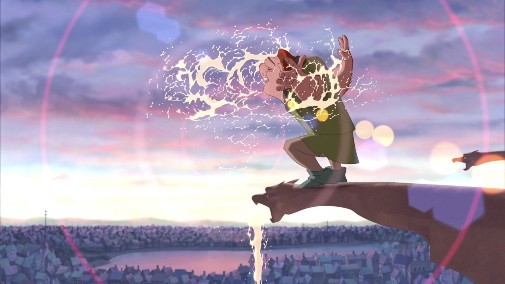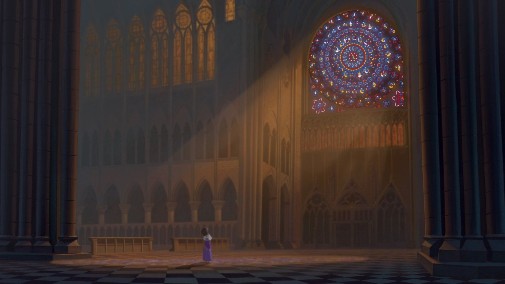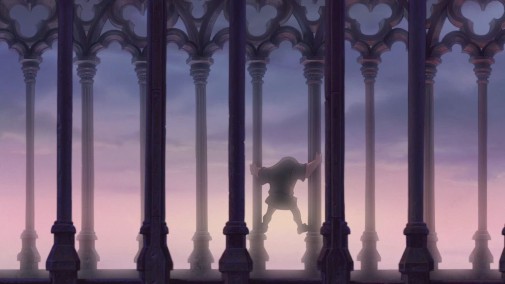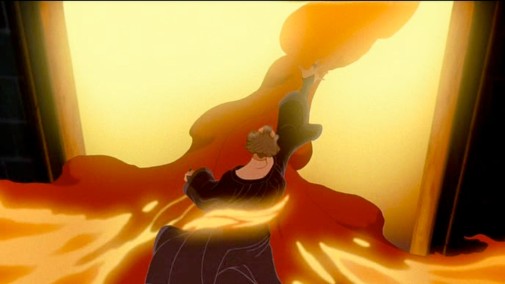
Do you know what the first movie you watched in a theater was? While I have no memory of the event, my parents were kind enough to remember my inaugural trip to the movies. When I was just two, they took me to see the latest Disney flick to hit theaters, The Hunchback of Notre Dame (1996). Supposedly, I was besotted by the sight and, when the picture was released on VHS, proceeded to re-watch it to my heart's content. I still have that videocassette today, a treasured memento of childhood and a token of a kid's blossoming love for cinema. So today, as The Hunchback of Notre Dame turns 25, I revisited that underrated classic of the Disney Renaissance and see if I still loved it…
Victor Hugo and the House of Mouse don't seem like a very logical pair. Indeed, reading up on The Hunchback of Notre Dame's behind-the-scenes drama and examining the film, one can notice the tensions between source material and the Disneyfied veneer of the finished product. From a design, narrative, and even sonic standpoint, the film's an ungainly mixture of compromises and contradictions, a decidedly adult story being twisted out of shape to fit a standard entertainment model for the whole family. And yet, no matter how much the studio was interested in selling kids' entertainment, The Hunchback of Notre Dame remains a dark picture beneath the layers of gargoyle hijinks and slapped-on happy endings.

Something like 1985's The Black Cauldron may be more outwardly edgy in the context of Disney toons, but that's primarily adolescent affectation and a matter of cosmetics when compared to this 1996 musical. From its thunderous prologue, The Hunchback of Notre Dame is playing with sounds, imagery, and themes that transcend the fairytale fantasia of most Disney films of this period. No matter how much the 20-plus screenwriters changed from Hugo's novel, the story set in 15th-century Paris is still partially about Quasimodo, a deformed social outcast whose life is shaped by widespread prejudice and the influence of a crazed religious fanatic. Claude Frollo (how I hated to share a name with the villain when I was a kid) might have been a clergyman in the original text, but Disney made him a magistrate to avoid offending the church. This alteration wasn't a new invention, mind you, since it was already featured in the 1939 movie adaptation.
Nevertheless, the character's hypocritical purity remains strong in the cartoon, and the relentless hatred against the Gypsies of Paris became his principal character trait. That and his lustful obsession with Esmeralda, the only person to bestow Quasimodo with the kindness of a friend. Though the cosmic misanthropy of the 1831 novel was considerably sanded-off, the cruelties of this cartoon world are still viscerally felt. Watching Quasimodo be pummeled with produce by an angry mob is upsetting beyond words. Similarly, there's the spectacle of Esmeralda at the stake, flames surrounding her like molten gold falling upwards, all while Frollo grins at her through the smoke. No quantity of cheery talking gargoyles could hope to counterbalance that, no matter how brutishly they tried.

And that brings us to what's perhaps the most surprising part of the film. While Disney's The Hunchback of Notre Dame is not a faithful Victor Hugo adaptation, it is a functional story with well-rounded characters. Tonal incoherence aside, the House of Mouse dared to tackle a significant quantity of the complicated ideas that concerned the 19th-century writer whose artistic beliefs weren't necessarily in opposition to commerce or popular entertainment. More importantly, Disney perpetuated Hugo's mission in making people more interested in Notre Dame de Paris. Both novel and film are as much about Gothic architecture as they are about their characters. The edifice's wonder that the book immortalized with words is translated into movie magic by the possibilities of animated cinema.
The camera can fly through the cathedral's screen recreation with a sort of fluidity that's impossible in live-action movies. Hell, it's impossible in most animated films. Furthermore, there's a magnificent sense of scale that stems as much from technical precision as from Gary Trousdale and Kirk Wise's direction. The relationship of the individual to crowds, buildings, and cities is intrinsic to the movie's visual language. If not because of Disney's The Hunchback of Notre Dame, I might not have been as adamant about visiting the cathedral both times I was in Paris during my youth. After the fire that destroyed a good portion of the building in 2019, I'm incredibly thankful for those experiences. Furthermore, I doubt I'd have become so interested in Victor Hugo from an early age. In summary, I wouldn't be the same person as I am today and all because of beautiful animation.

Still, even more monumental than the set design or camera movements, The Hunchback of Notre Dame is blessed with what I'll readily call Alan Menken's best musical compositions. The songs, co-written with lyricist Stephen Schwartz, aren't consistently superlative, but those that do work are spellbinding. Beyond them, the score is a miracle of Catholic liturgy woven together with Broadway-style grandeur. The result is frankly overwhelming. Even watching at home, I always feel goosebumps during the opening salvo of bell-ringing, the choral interruptions to Esmeralda's plea for God's mercy, and the climax of the "Sanctuary" track.
No exploration of The Hunchback of Notre Dame would be complete without mentioning its best musical number. As the last passages of the twinkling "Heaven's Light" bleed into Latin chant, Frollo takes center stage to perform one of Disney's best villain songs. "Hellfire" is a hymn of genocidal hatred erupting from a volcano of Catholic sexual repression. He lusts after what he cannot have, what he thinks is ignoble. Watching him debate with himself, a personal conscience that manifests as a sea of Cardinal-red shadows, one gets a sense of the warring tempest storming inside him. It's shockingly blatant, evoking prayer in the lyrics as well as the voluptuousness of temptation given form by flickering flame.

I don't think I fully understood the more adult aspects of the plot or its symbolism when I was a child, but I did perceive the strength, the truth, of the emotions. That's what exceptional visual storytelling and robust musical expression will do for you. Even audiences who don't get it immediately still understand the essence of the thing. In that regard, The Hunchback of Notre Dame transcends the basic valor of its cartoon provocation, its gutsiness, proving itself an awe-inspiring, if imperfect, work of art. It's interesting growing old alongside this favorite flick, becoming increasingly aware of the themes it hints at - the troubled history of the anti-Romani oppression throughout Europe, the horrors hidden behinds façades of religious piety, the ravages of desire that's muzzled and becomes rabid. Every time I re-watch it, I learn a new thing about it and myself. If that's not the mark of a great movie, I don't know what is.

The Hunchback of Notre Dame is streaming on Disney+.